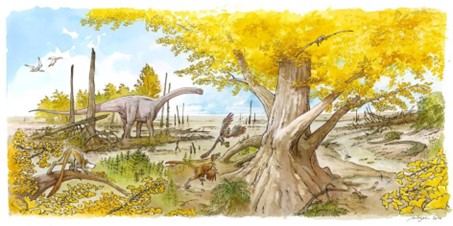
EcoClimat
Evolution of the Continental Ecosystems of the Charentes at the Jurassic – Cretaceous Boundary
Scientific responsibility :
- Johann Schnyder
- Frédéric Fluteau
- Ronan Allain
- Valérie Daux
- Pierre Sépulchre
- Jérôme Aléon
- Romain Augier
- Romain Vullo
- Arnauld Vinçon-Laugier
- Laurent Crépin
- Jean-François Tournepiche
- Dominique Abit
- Pierre Lavaud (Mazan)
- Boris Haouassi
- Benoit Audoin
- Vincent Audoin
Methodological axes :
Thematic fields :
Disciplinary sectors :
Partnership :
- ISTO
- Géosciences Rennes
- LGL-TPE
- Musée d’Angoulême
- Association paléontologique Dinoléron
- CMGO
- Carrières Audoin & Fils
Funding :
- DIM PAMIR
- Fondation de France
Project ID : IDF-DIM-PAMIR-2025-4-024
Summary :
On a global scale, the Jurassic-Cretaceous transition is classically described in the scientific literature as a period of biological crisis, during which continental ecosystems underwent major faunal renewal. However, this transition was also accompanied by a major marine regression, a geological context less conducive to the preservation of fauna and flora. In other words, the biological crisis observed could be at least partly artefactual, stemming from the scarcity of continental deposits dating from the Early Cretaceous compared with the more abundant deposits at the end of the Late Jurassic. The Charentes region (northern Aquitaine Basin) is particularly interesting in this respect, as it hosts palaeontological deposits dating from both the Late Jurassic and Early Cretaceous periods. The palaeontological deposits at Chassiron (Charente- Maritime), Cherves-de-Cognac (Charente) and Angeac-Charente (Charente) have all yielded abundant and diverse continental vertebrate faunas. The various dating studies carried out indicate that the Angeac- Charente deposit is slightly younger than the Cherves-de-Cognac deposit, which dates from the earliest Cretaceous (Berriasian, 143 million years old), itself younger than the Chassiron deposit, which dates from the latest Jurassic (Tithonian, 150 million years old). These three palaeontological localities therefore represent a key temporal succession for understanding how the continental ecosystems of the northern Aquitaine Basin evolved around the Jurassic-Cretaceous boundary. However, uncertainties persist regarding the precise dating of these three deposits. The objective of the EcoCLimat project is to enhance the accuracy of the chronological sequence of these deposits using robust dating techniques and to meticulously characterize the paleoenvironment, palaeogeography and palaeoclimate of this region. This is essential for studying the evolution of continental ecosystems during the Jurassic – Cretaceous transition.
Post-doctoral student: Romain Pintore

